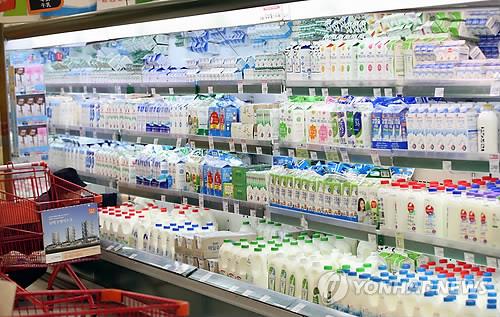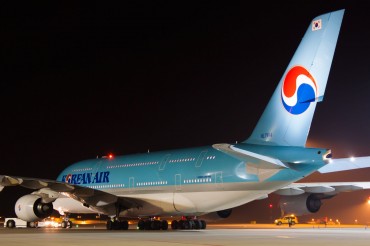
The picture shows a refrigerator filled with milk cartons in a supermarket in Seoul. (Image : Yonhap)
SEOUL, Dec. 7 (Korea Bizwire) – South Korea’s milk industry has been mired in a quandary over increasing milk inventories over the past years due to an oversupply and sluggish consumption amid falling birthrates and a prolonged economic slump.
In a desperate bid to tide over the difficulty, the industry has been trying to cut milk production, but the glut shows no signs of easing as milk producers are determined not to lower prices to help boost consumption.
Market watchers say the root cause of the supply-demand imbalance is the so-called raw milk price linkage system, a pricing agreement that a dairy producers’ group and the government reached in 2012 following farmers’ fierce protests over falling prices.
Under the system, the price of raw milk is linked to production costs based on numbers released by Statistics Korea and the preceding year’s inflation rate, instead of being determined by market forces.
The milk inventory has been on a steady rise since 2013 when the government encouraged the dairy industry to increase production to overcome an undersupply stemming from a massive outbreak of foot-and-mouth disease in 2010 and 2011.
Powered milk inventories came in at 262,000 tons as of end-September this year, up 3,000 tons from the end of last year, according to data from the Korea Dairy Committee (KDC). Overloaded fresh milk is dried to powdered milk for preservation.
The stock has floated over the 200,000 ton level for nearly a year since it touched the line in November last year for the first time in 11 years, while reaching an all-time high of 280,000 tons in April.
Making matters worse, the upward trend of raw milk production has continued for years, with the monthly milk production having hovered around 180,000 tons. About 173,000 tons of fresh milk were produced in September this year.
Despite the increased production, South Korea’s milk consumption has been on the wane.
South Korean households spent an average 12,088 won (US$10.38) in buying fresh milk per month in the second quarter of this year, down 16.3 percent from the same period in 2012, according to the Korea Rural Economic Institute. They bought a monthly 4.92 kilograms of milk over the cited period, down 15 percent from 5.79kg.’
“As the foot-and-mouth disease swept across the country in 2010 and 2011, a great number of milk cows were culled, resulting in a sharp drop in milk production,” said Yoon Hyung-yun, director of the Supply-Demand Planning Team at the KDC.
“The government came up with production expansion plans to restore the volume. But after that, consumption plunged due to big social issues like the deadly Sewol ferry sinking, an outbreak of Middle East Respiratory Syndrome (MERS), a demographic change and a sustained economic downturn.”
As consumption has showed no signs of recovery, dairy farmers are seeking to solve the problem on their own: slaughtering cows.
The Seoul Dairy Cooperative, which is in charge of 35 percent of the country’s milk production, has killed 5,400 milk cows since January, while the KDC has decided to slaughter 3,633 cows by the end of this year.
According to the Ministry of Agriculture, Food and Rural Affairs, the number of slaughtered cows rose 38.6 percent on-year to 51,315 during the first nine months of the year.
“Producers have left no stone unturned to solve the problem,” said Yoon. “The ball is now in the court of dairy companies and even the government. They should ramp up efforts to help boost milk consumption.”
The agriculture ministry said that the KDC and other related players including farmers and consumer rights groups have formed a consultative body to discuss ways to improve the price-setting system of milk.
“The consultative body has been looking into the system to determine whether to maintain the price system or to scrap it,” said Ha Wook-won from the ministry’s Livestock Management Division.
“The government is considering programs to support milk producers and build the industry’s infrastructure to keep up with the changing trend.”

Officials from the National Agricultural Cooperatives Federation, or Nonghyup, participate in a campaign to promote milk consumption in Seoul on July 2, 2015. (Image : Yonhap)
Slumping milk consumption has prompted dairy companies, who have been struggling from a drop in revenues, to diversify their business portfolios.
Seoul Dairy Cooperative, a group of milk farmers, posted a loss of 18.4 billion won for the first half of this year, marking a half-yearly deficit for the first time. Its first-half operating profit plunged 84.5 percent on-year to 5.2 billion won.
But other dairy companies, who have coffee and baby formula businesses under their wings, have fared better.
Namyang Dairy Products Co. swung to a net profit in the second quarter of this year for the first time in two years, posting 6.1 billion won in operating profit, while Maeil Dairy Industry Co. saw its operating profit jump 69.3 percent on-year to 13.9 billion in the third quarter.
Their strong bottom line was led by brisk sales of coffee and yogurt products and particularly exports of baby formulas to China.
Namyang’s milk business accounted for 29 percent of the company’s entire sales last year, with 21 percent for yogurt products, 16 percent for baby formula and 10 percent for coffee.
Maeil depends on fresh milk for some 24 percent of its sales, followed by formula with 10 percent and coffee drinks with 10 percent.
They focus on rising demand for milk products, including infant formulas, as Beijing scrapped its decades-old one-child policy.
According to a report by KDB Daewoo Securities Co., Namyang shipped 23 billion worth of infant formulas to China last year and expected the figure to nearly double to 45 billion this year, while Maeil’s China exports are also expected to reach 45 billion won in 2015.
Experts point out that the fast-growing Chinese baby market is one of the biggest solutions for South Korea’s saturated dairy industry.
“China’s formula market is exploding,” said Baek Woon-mok, an analyst at KDB Daewoo Securities. “Chinese consumers tend to prefer imported brands to Chinese ones. South Korean companies can appeal to such a tendency.”
(Yonhap)






